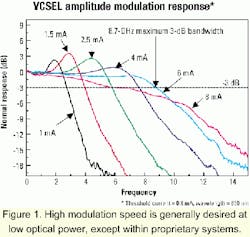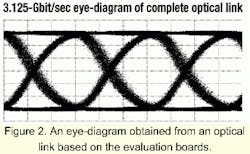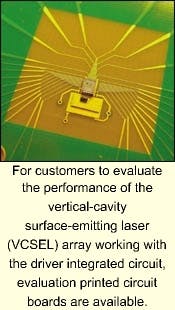VCSEL-based transmitters for parallel data communications
The need to access the Internet is pushing the demand for input/output subsystem performance, reliability, scalability, and flexibility.
STEPHAN HUNZIKER, Avalon Photonics Ltd. and Richard Annen, Helix AG
There is a rapidly growing request for high aggregate data rate in the data-communications market. Scalable computer systems, switching systems, or generally, systems with high data throughput, require high-speed inter/intraboard, backplane, and LAN interconnections. The required aggregate data rates of tens of gigabits per second can be achieved either by using serialization very-high-speed serial transmission and deserialization or parallel links with moderate speeds per channel.
The link architecture in a particular case is a tradeoff between the bandwidth/noise of the optoelectronic components, fiber, complexity of the electronics, and required space. If only one fiber can be used (e.g., due to high leasing costs) for a link, it is meaningful to go to serial transmission. That requires expensive high-speed transceivers, but in the end, the costs are low because of the low fiber leasing costs.
In the case of very-short-reach links, where the transceiver costs are significant, parallel transmission may be much more convenient, because low-cost electronics and optoelectronics can be used and the fiber costs are less of an issue. Even for transmission over some tens of centimeters, parallel optical links are attractive due to their electromagnetic compatibility immunity and low loss.
Parallel fiber-based links using fiber ribbons, V-groove packaging technology, MT/MTP connectors, or even printed-circuit-board integrated optical backplanes are becoming promising low-cost technologies for high-speed data transmission over short distances.
Those links consist of multimode fibers/ waveguides or free-space links with mirrors and lenses and low-cost silicon-based electronics. Vertical-cavity surface-emitting laser (VCSEL) arrays are ideal sources for parallel optical transmitters because of low production, testing, and packaging costs and high bandwidth. Low-cost silicon or indium gallium arsenide (InGaAs) photodiode arrays are required for the optical receiver front ends.Good performance means low bit-error rate (BER), usually a BER of 10-9 or better, which is the product of large eye opening and low noise. That requires flat frequency response, high bandwidth, and high relaxation damping, as well as low optical feedback from the photodiode back to the VCSEL. Butt-coupling lowers the transceiver costs.
In that case, good coupling1 is not easy, but important, and additional optics may be required in some cases to avoid mode partition noise2 due to non-efficient laser-fiber coupling. Particularly large-aperture multitransverse-mode VCSELs are critical in this respect. Singlemode short-wavelength VCSELs are not yet available for commercial applications due their lifetime limitations. For singlemode operation, a low-aperture diameter is required, which leads to very high current density that adversely affects reliability.
A characteristic of multitransverse-mode VCSELs is the reduced speckle contrast in multimode fibers and therefore the reduced modal noise due to connector misalignment.3 If parallel fiber ribbons with MT receptacle transceivers are used, light can directly be coupled into an MT ferrule at low cost.4 Optimization of VCSEL reflection sensitivity can then help to avoid problems with noise and jitter. The Table on page 156 details the specification of data-communication VCSEL arrays that can be operated above 3.125 Gbits/sec per channel.
Unlike conventional edge-emitting laser diodes that emit light from their cleaved sides, VCSELs are top or bottom emitters. The resonator of a VCSEL is very short, which allows high-speed modulation. That implies high mirror reflectivity to establish lasing action. High reflectivity can be realized efficiently only for short-wavelength emitters today (GaAs material system).VCSELs are relatively simple to fabricate and are therefore ideal sources for high-speed, low-cost optical transceivers. They consist of a substrate and an active area with quantum wells-two Bragg mirrors. They can be tested on wafer and designed as one- or two-dimensional arrays with a lithographically precisely defined pitch for low-cost packaging.
There are two important limitations of the VCSEL modulation speed: parasitics and relaxation damping. Relaxation damping limits the maximum bandwidth of 850-nm quantum-well VCSELs to slightly above 20 GHz.5
High modulation speed (see Figure 1) is generally desired at low optical power (eye safety6), except within proprietary systems. A high photon number inside the resonator provides high bandwidth and high damping. Low optical output power can then be achieved implementing high top mirror reflectivity. Low-threshold current is a prerequisite for low drive currents. Uniformity of the VCSEL's parameters within the array is important. Usually, monitoring of individual lasers is not provided for. Therefore, the array yield will not match that of the individual VCSEL.
The first results of our large-scale lifetime testing of the 850-nm multimode oxide VCSELs, after 3,000 hours of device testing, indicate meantime to failure (MTTF) greater than three million hours at operating conditions of >1 mW output power corresponding to an average drive current of 5 mA. Thus far, we have observed no failures at 75°C and 100°C out of 500 lasers tested. The failure criterion used was a -2-dB drop in optical output power at 5-mA injection, measured at 25°C.
Using the Honeywell/Infineon/ Agilent models for failure acceleration, we estimate the reliability of our devices to be in excess of 10 years at 70°C. This reliability study is ongoing and more data is available on request.
Driver chips, such as those manufactured by Helix AG, are optimized to work resiliently in a standard digital environment. They operate from a single 3.3-V supply. Their electrical high-speed interfaces are compatible with low-voltage differential signal (LVDS), current mode logic, and positive-referenced emitter-coupled logic (PECL) standards and allow both AC and DC coupling. The driver stages provide laser currents up to 8 mA mean and 8 mA peak-to-peak with high uniformity and low drift over a temperature range of 0°C to 100°C and over a supply variation of ±10%.The driver output currents are set by either a digital or an analog interface. The digital serial interface is used by an external microcontroller to set individual drive currents for each VCSEL in the array, allowing to equalize non-uniformities to implement temperature-compensation schemes and supervision procedures. The analog interface requires only two external resistors to set the drive current common to all channels, with linear temperature compensation.
VCSEL supervisors control the voltages across the devices and may be used to detect fault conditions. The driver ASICs are fabricated in a commercial silicon germanium BiCMOS process technology. Bipolar transistors provide high-speed current switch capability, where CMOS allows the integration of higher driver functionality at low power and low silicon-area requirements.
To penetrate the 10-Gbit/sec per channel regime, a new design approach is being developed that combines current and voltage driving. This technique achieves fast transients, even for large VCSEL series resistance, that are typical for devices tuned for high speed.
The drivers for 4x3.125 Gbits/sec and 12x3.125 Gbits/sec are compatible with VCSELs. Corresponding characterization reports are available on demand. Figure 2 shows an eye-diagram obtained from an optical link based on the evaluation boards.
Conventional VCSEL arrays have a bottom n contact. Such a structure can be considered as a short microstripline with a small dielectric layer (due to the non-isolating substrate), which results in a very low impedance (i.e., a pure capacitance). This capacitance decreases the bandwidth of the device. To increase the VCSEL bandwidth, at least this parasitic capacitance has to be minimized. A transition from microstrip to coplanar waveguide (CPW) structures is a solution. CPW allows controlled impedance wiring. Using a CPW layout structure for the one-dimensional arrays has the advantage that all contacts are on top, meaning simple microwave probing the n-drive and p-drive is technologically simple, and wedge as well as flip-chip bonding is possible. The oxide capacitance exists, but the wiring now has to be considered as a short transmission line matched to the VCSEL's input resistance.High-speed VCSELs and drivers are interconnected by bond wires or solder bumps and short transmission-line sections (on-chip substrate). Bond wires can be used up to data rates higher than 10 Gbits/sec. To achieve high modulation speeds, the matched wiring, and particularly the driver VCSEL interconnection, has to be kept short and the oxide capacitance should be low.
High-speed optical parallel data communications is very attractive for existing and future backplane and short-range data-communications applications. There is a strong demand-even today-for nx1.25-Gbit/sec, nx2.5-Gbit/sec, and nx3.125-Gbit/sec links. One of the next steps for optical-backplane applications will be 10 Gbits/sec per channel. New multimode fibers optimized for short wavelength can significantly increase the fiber span at 10 Gbits/sec (i.e., 1.6 km-GHz at 850 nm). Coarse or wide WDM can further multiply the aggregate data rate.
Stephan Hunziker is the data-communications product manager for Avalon Photonics Ltd. (Zurich), and Richard Annen is a chip-development engineer at Helix AG (Zurich). They can be reached at their respective company's Websites, www.avalon-photonics.com and www.helix.ch.
- J. Heinrich, E. Zeeb, and K.J. Ebeling, "Butt-coupling efficiency of VCSELs into multimode fibers," IEEE Photonics Technology Letter, vol. 9, pp. 1555-1557, 1997.
- L. Zei, S. Ebers, J.R. Kropp, and K. Petermann, "Mode partition noise of multimode VCSELs due to spatial filtering," ECOC '00, Munich, Germany, vol. 2, pp. 63-64, 2000.
- K.H. Hahn, M.R. Tan, Y.M. Houng, and S.Y. Wang, "Large-area multitransverse-mode VCSELs for modal noise reduction in multimode fibre systems," Electronics Letter, vol. 29, no. 16, pp. 1482-1483, 1993.
- H. Kosaka, M. Kajita, M. Yamada, Y. Sugimoto, K. Kurata, T. Tanabe, and Y. Kasukawa, "Plastic-type receptacle-based VCSEL-array modules with one and two dimensions fabricated using the self-alignment mounting technique," ECTC '97, San Jose, CA, pp. 382-390, 1997.
- K.J. Ebeling, "Vertical semiconductor lasers (VCSELs) for data communications," Short Course, ECOC '00, Munich, Germany, 2000.
- European Standard EN60825-1+A11/IEC 825-1. ANSI Z-136.1. Laser safety standards.



